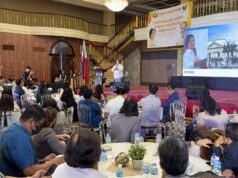CITY OF SAN FERNANDO – The Department of Environment and Natural Resources here has updated its list of illegal logging hotspots in Central Luzon and identified five areas in the region which are now under close monitoring by its Anti-Illegal Logging Task Force (RAILTF).
DENR regional director and RAILTF chairman Maximo Dichoso identified the hotspots as the Zambales-Pangasinan Road, the Botolan-Capas boundary, the Bongabon-Mari Aurora boundary, the Ipo Watershed in Bulacan and Nueva Ecija.
All routes that could be used for transporting illegal forest products from there areas have been plugged through the establishment of monitoring centers, Dichoso said.
The monitoring centers are located in barangays Dinadiawan and Gupa in Maria Aurora in Aurora; Puncan in Carangglan, Calaanan in Bongabon, and Bato Ferry in Laur all in Nueva Ecija; Alagao in Sal Ildefonso and Matictic in Norzagaray in Bulacan and Paraiso in Tarlac City.
“Both aerial and land-based surveillance in the vicinities of the hotspots are conducted by these centers to prevent the cutting and harvesting of timber in the forests and their transport to wood-processing plants,” Dichoso said.
Despite reports of illegal logging in some parts of Central Luzon, particularly in the area of the Sierra Madre mountain ranges, the DENR said the region’s forest cover is still capable of absorbing some 206 million metric tons of carbon dioxide at any given time.
“This can significantly boost the government’s effort to mitigate the impacts of climate change, said Dichoso.
Dichoso said Central Luzon still has 589, 489 hectares forest cover which, he noted, “can act as carbon sink and significantly contribute in cleansing the air of pollutants.”
“Carbon dioxide is one of the greenhouse gases that contribute to global warming and propel climate change. The only way to reduce it is by planting more trees,” he explained.
He noted that “although scientists and climate change experts vary in their estimates on the amount of carbon dioxide that a single tree can sequester, they all agree that one tree, regardless of species, could capture at least 0.56 MT of carbon dioxide in its lifetime.”
“At an average spacing of four by four meters of trees, forestry experts estimate that Central Luzon’s forests would have roughly more than 368 million trees of different species,” he said.
Citing a research study, Dichoso said that “if ten trees can capture the emission of one motor vehicle, then Central Luzon forests can sequester the carbon emissions of more than 36 million motor vehicles.”
Latest statistics from the Land Transportation Office has revealed that the country has more than six million registered vehicles, of which 800,000 are in Central Luzon.
“Pres. Aquino’s National Greening Program which aims to plant 1.5 billion trees covering 1.5 million hectares of forestland by 2016, is estimated to capture about 840 million MT of carbon dioxide and contribute to global efforts to mitigate climate change,” Dichoso added.




